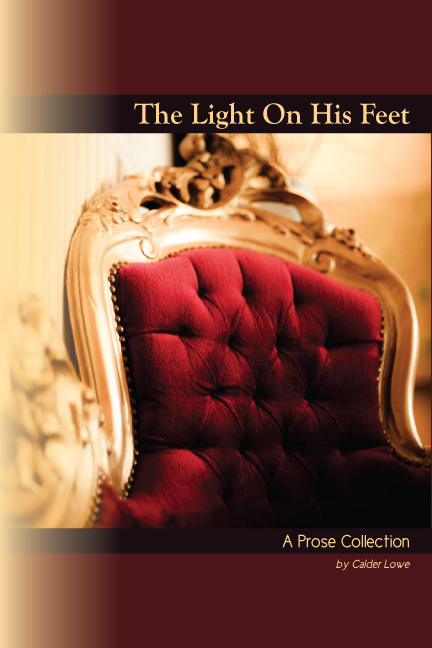The Joy of Cooking (Airport Novel Musical Poem Painting Film Photo Hallucination Landscape)
by Tan Lin © 2010. Wesleyan University Press. 219 pgs.
ISBN: 978-0-8195-6928-8 (Cloth), 978-0-8195-6929-5 (Pbk)
A Review by Maureen Thorson
There are companies that sell books by the yard. Books thus sold are not to be opened and read; instead, they are a sort of set decoration. Bound law reports are advertised as perfect for adding a frisson of intellectual heft to your living room, while ancient leather-bound books with gilt titles will convey old-money elegance to all who view them nestled on your shelves. Nor is the drive to use books as accent pieces limited to professional decorators; when my husband and I recently purchased new bookshelves that allowed us to redistribute our own collection, the resulting gaps on the shelves annoyed my husband intensely – without jam-packed shelves, our living room immediately took on a less studious air.
This sort of reading – experiencing books (and other works of art) not for the information they contain ¬¬– but as mood-altering decorative objects or signifiers akin to area rugs or brand logos, is one of the central concerns of the Tan Lin’s latest book. Enlarging on his theory and practice of “ambient stylistics,” he describes an aesthetics of poems, paintings, and photographs as thermostat-like “regulators of energies,” that should not stir memories (and their attendant emotional upheaval), but permit feelings to disappear beneath a mask of superficial repetition or relaxation. “Reading a book should be like going out to a restaurant or buying a candleholder. It should enhance the mood of the space that it occupies.” Lin advances a place for art that acts not as a focal point for emotional catharsis, but as a hypnotic, repetitive and “sampled” background to the reader or viewer’s experience. “Poetry as wallpaper. Novel as design object.”
Lin asks us what might be the “forms of non-reading and the forms a non-reading might take,” wherein poems can be looked at, rather than formally read, and “the page should turn before you got there.” Paintings should be sampled, rather than sequenced – little bits of them repeated, trancelike, rather than the whole presented as a complete narrative or emotional picture. Photographs, rather than recreate the experience of something other than themselves, should reflect the blankness and non-theatricality of the world “out there,” “making visible the memories we are not having,” and our forgetting of “things that are repeating themselves beside the world. A poem or painting or landscape is beautiful at the moment it is forgotten, when it subtly accentuates a style or mood without drawing attention to itself, like drapes or a shade of paint. If poetry (and other art) is supposed to hold up a mirror to life, then, Lin advances, it should not draw attention to itself. It should be, well, boring, rather than narrative or arresting, and should convey little beyond a certain mood, or sense of style. As he says, “NIAGARA FALLS IS JUST A KIND OF PAINT.”
Reflecting his concerns, the physical structure of this book upends attempts to focus attention. The cover is a uniform dull sort of blue, without any images. The front of the book does not bear the title or name of the author as such. After all, as Lin says, things become beautiful – or, to put it another way, relevant to the greatest number of people – by being generic, empty and uniform, such that “the front of a book is always less interesting than the back of a book.” Instead of the traditional front of a book, Lin’s front cover reproduces no information other than (1) the number 11.07 – seemingly an allusion to his wife, (2) 22.95 – the price, and (3) some of the books’ Library of Congress cataloguing data, in very small, medium brown type. The title and author’s name appear on the back cover; also, images of the back covers of a number of other books appear scattered throughout the book’s third section, which compares modern, commercial architecture with books and reading. The book opens with acknowledgments that appear to have been lifted wholesale from another book; prefaces occur in the middle; there is a short section called “Direct Marketing,” which posits a number of forms and prices for the work; one essay is actually breaks off at the end of the page, only to be continued at the very end of the book, like a newspaper article that ran too long.
But the “ambient stylistics” discussed and practiced in Lin’s book does not just stand on its own; rather, the book engages in a call-and response with Laura (Riding) Jackson’s Rational Meaning: A New Foundation for the Meaning of Words. (Riding) Jackson spent more than forty years on this text, working at first with her husband, Schuyler Jackson, and continuing on long after his death. The book, finished in 1986, remained unpublished until 1997. In Rational Meaning, Jackson rejects most modern theories of linguistics (in which words have meanings that are socially or historically constructed, and thus liable to be altered). Although she also explicitly rejects any notion that words and their meanings stem from a supernatural source, she believes that words have, as Charles Bernstein explains it in his introduction to the work, “intrinsic meaning” – a meaning that is fixed, internal, and unswaying and “self-complete.” To believe or use words otherwise is to corrupt words out of their truth-value, thereby destroying and denigrating humanity’s linguistic birthright.
Bernstein calls Rational Meaning an “anti-poetics,” and Lin’s ambient stylistics could be described that way as well, inasmuch as the aesthetic necessarily posits that poetry, painting, and photography must take certain forms if they are to be “beautiful.” This mirrors (Riding) Jackson’s concern that words should be used in a certain way if they are to fulfill their “truth.” Lin, like (Riding Jackson) harbors concerns about the artistic use of words – not so much that there is a “true” use to words, but that words lose their truth as soon as they are set down in a fixed form – the book dies when it is finished. As such, the beauty of words lies in forgetting them, allowing them to be unmemorable, and to disappear. And the immortality of a book lies in its ability to never be finished, to transcend its own content and change it.
Accordingly, Lin’s affinity and engagement with Rational Meaning may have much less to do with its substance than its history. In their forty-odd years of work, Rational Meaning’s authors surely did not start on page one, and write straight through to the end (some 400 pages in the University of Virginia Edition, not counting the supplementary essays). Indeed, (Riding) Jackson wrote multiple prefaces for the book, each at different times in its writing, and finished with a foreword written in 1986. Whatever substance or form Rational Meaning had in 1986, it was also, necessarily, a documentation of its own evolution.
Lin’s book was written over a shorter, but not inconsiderable period, having been begun in 2001, and not published in final form until 2010 (although he published an earlier version through Lulu in 2005). Although readers are vaguely aware that revising and editing exist, we consume “finished packages,” and so we generally don’t think about process much. But the author must, particularly when there is no clear destination at the outset, but only a process in which the work is revised, added to, subtracted from, rearranged, and in some instances, not revised, but begun anew – repeatedly. Lin alludes to the history of his book most particularly in its middle sections, which contain, like Rational Meaning, multiple prefaces. These are all dated, and discuss particular autobiographical moments in a way alien to the first few sections, which concentrate more philosophically (and abstractly) on ambient stylistics.
Lin most clearly makes the connection between his own process and (Riding) Jackson’s in his editorial note, a re-write of the editorial note that accompanies Jackson’s book. Rational Meaning’s editor begins his note by announcing that “my part in the production of this book has consisted in editing a typescript produced and revised over several decades by two authors.” Reverentially, the editor states that he chose to hew “as closely to the original typescript as possible” – even though the idea of an “original” typescript is a downright paradox for such a book. Lin, turning that editor’s words against him, states outright in the note for his own book that “My collaborative aim in the production of this work has been to offer a series of intra-textual corrections in a typescript produced and renovated over several decades by more than one author.” Winking at (Riding) Jackson’s philosophy, he blandly states, “There is truth and there is truth.” What we have here is a history, not one that is “unfolding” – as though that had already all been there and simply needed its creases smoothed out – but one that is constantly remaking, “renovating” itself. Indeed, it’s not done yet – Lin recently released a 100-page appendix to his book, which can be downloaded for free from Lulu.com.
Although it begins with a focus on ambient stylistics, and is grounded in engagement with Rational Meaning, Lin’s book is not one that stays relentlessly on-topic – in its 219 pages (sans new appendix), it covers modern architecture; the logic-gate-like behavior of American shoppers; the “rented celebrity” of reality television; flash mobs; a theory of slow reading; avant-garde cooking; the bizarre disconnect between “Chinese” cookbooks and actual Chinese food, as experienced by someone who knows the difference; and the dissociative landscapes of airports, wherein the luxury items that crowd duty-free shops (“wasting assets”) are purchased as “counter-stimulants” to amnesia. Digressions abound, and their threads, one dropped, may not be picked up again. Philosophical explanations give way to straightforward personal history, and then to poetry collaged with photographs.
However, the substance is always engaging, and occasionally highly surprising. For example, while many people have commented on the relationship between branding and meaning – a purse with a Louis-Vuitton means something different than one without– Lin goes one step (or two or three) farther in applying this theory to buildings. Lin argues that so-called “bar-code buildings,” – those with naming rights, such as stadiums – exhibit a weird signifier-signified relationship in which the building’s physical structure is unchanged and unchanging, but its “underlying ID code” changes with its sponsorship and name. By being able to take on new names, new IDs, and thus alter their market relevance, such buildings can “outlive their data,” as when the stadium where the Washington Wizards and Washington Capitals play changed from being the MCI Center to the Verizon Center, after MCI went bankrupt in the wake of the WorldCom scandal. Compared to such “bar-code buildings,” stadiums without naming rights are “outmoded pictorial concepts” that “resemble the book,” in their inability to outlive their own information. (More shades of Laura (Riding) Jackson here: if words are supposed to have a single, unalterable meaning, then how can they outlive a meaning that has lost its “market relevance”? They can’t. But if your book’s content keeps changing – as with, say, the addition of a 100 page post-publication appendix, well, all bets are off.)
Lin is a particularly keen observer of the ways in which commerce shapes culture, and vice versa. No one had put for me quite so succinctly the fact that “variation is the mantra of the new standardization,” a fake freedom in which you can have an iPod of any color you like, so long as you have an iPod. “Irresolvable desires,” Lin writes, “are the most inefficient of market forces,” and so they are written out of the equation of modern commerce. At the same time, shopping takes place increasingly in “commercial structures that are immune to becoming historical” – think of any Wal-Mart. Function erases form, such that both commercial spaces and the commodities they house have (or will have) the function of destroying memory and history “at a standard rate.” Perversely, this may have the function of drawing people together, as “our most beautiful desires are our most unspecific ones” – that which is homogenous and generic is most likely to have widespread relevance and therefore be most valued.
The sheer multiplicity of ideas is dizzying, and although the book clearly has a few central concerns, they are not overriding: in the sections that focus on ambient stylistics, for example, Lin is not particular about ensuring that he presents ideas that can only be easily related to or squared with that theory. Instead, he riffs. He leads the reader down paths that circle, snake, and sometimes dead end. Despite the faux-academese of the sectional titles – “A Field Guide to American Painting,” “A Dictionary of Systems Theory” – this isn’t a text book. Instead, the reader winds up with the same three-dimensional feeling one gets when looking at a huge sculpture: when you can see the front, you can’t see the back. The complete picture is never before the reader; rather it is imagined and always out of sight.
But that’s a large part of the pleasure here; the book’s resistance to uniformity, at the same time that it appears to bless uniformity as an aesthetic ideal. There is a necessary paradox in writing a book while positing that books are a dead art form to the extent that they are bound to the information they contain, rather than acting as logo-like conveyors of a changeable mood information. A theory of boring art, generic feelings, and commercially valuable vagueness – because, after all, what value is there except commercial value? What price beauty? $6.99, if we measure it in cheap lipstick. What price truth (or commercial equivalent)? $22.95, if you measure it in terms of this book . I think you’re getting a deal.
Maureen Thorson lives in Washington, DC, where she co-curates the In Your Ear reading series. Ugly Duckling Presse will publish her first book, Applies to Oranges, in 2011.




